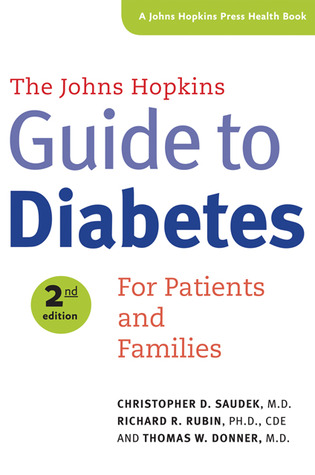Shaun's Reviews > The Johns Hopkins Guide to Diabetes: For Patients and Families
The Johns Hopkins Guide to Diabetes: For Patients and Families (A Johns Hopkins Press Health Book)
by

by

If I had to describe this book in one word, it would be "dense," 470 pages small print, few pic/illustrations dense.
I was disappointed in this book as it kind of summarized for me what I see as a major failing in the US system of sick care.
First and foremost, I think the authors do Type 1 diabetics and Type 2 diabetics a disservice by not giving them each their own book. They are such different diseases and the demographics are generally quite different as well.
Type 1 diabetes is caused by an auto-immune disease that attacks the pancreas, essentially killing the insulin producing cells. It is historically referred to as juvenile diabetes because it is often diagnosed during childhood, though sometimes does not show up until later in life. These diabetics will be on insulin for the rest of their lives. There is a genetic component to the disease, but genes alone are not the only determining factor. It is believed someone has the genetic predisposition, but than something turns on the gene. What, we still don't know.
Type 2 diabetes, once called adult-onset diabetes because it was generally only seen later in life, is characterized by a resistance to insulin. So that their bodies are still producing insulin, just not enough to get the job done, thanks to a resistance. There is a strong association between diabetes and Type 2, and there is also a strong genetic link.
Working in health care, I would say your average Type 2 patient is much different than your average Type 1, and while they share some of the same struggles, they differ in many significant ways and those difference get lost in this book.
The book is also very technical, going into the nuances of dosing insulin, the struggles of glucose monitoring, and the various associated health conditions. And while nutrition, exercise, and sleep are mentioned in passing, few of the 470 pages are dedicated to their role in preventing and/or managing diabetes, Type 1 or Type 2.
I did learn a few things that even as a clinician with medical training I did not know, which is always nice. I just do not see how this book would be helpful to 99.9% of the patients I deal with who live with diabetes or its complications. And as is the case with medicine these days, it focused more on treatment. At least one chapter on prevention would have been nice. I also think the authors did not take enough time to discuss prediabetes, the risks, or concerns.
Finally, I thought this book seemed more geared toward and more useful for the Type 1 diabetic, which is a shame seeing as according to the authors the majority of diabetics worldwide are Type 2.
I was disappointed in this book as it kind of summarized for me what I see as a major failing in the US system of sick care.
First and foremost, I think the authors do Type 1 diabetics and Type 2 diabetics a disservice by not giving them each their own book. They are such different diseases and the demographics are generally quite different as well.
Type 1 diabetes is caused by an auto-immune disease that attacks the pancreas, essentially killing the insulin producing cells. It is historically referred to as juvenile diabetes because it is often diagnosed during childhood, though sometimes does not show up until later in life. These diabetics will be on insulin for the rest of their lives. There is a genetic component to the disease, but genes alone are not the only determining factor. It is believed someone has the genetic predisposition, but than something turns on the gene. What, we still don't know.
Type 2 diabetes, once called adult-onset diabetes because it was generally only seen later in life, is characterized by a resistance to insulin. So that their bodies are still producing insulin, just not enough to get the job done, thanks to a resistance. There is a strong association between diabetes and Type 2, and there is also a strong genetic link.
Working in health care, I would say your average Type 2 patient is much different than your average Type 1, and while they share some of the same struggles, they differ in many significant ways and those difference get lost in this book.
The book is also very technical, going into the nuances of dosing insulin, the struggles of glucose monitoring, and the various associated health conditions. And while nutrition, exercise, and sleep are mentioned in passing, few of the 470 pages are dedicated to their role in preventing and/or managing diabetes, Type 1 or Type 2.
I did learn a few things that even as a clinician with medical training I did not know, which is always nice. I just do not see how this book would be helpful to 99.9% of the patients I deal with who live with diabetes or its complications. And as is the case with medicine these days, it focused more on treatment. At least one chapter on prevention would have been nice. I also think the authors did not take enough time to discuss prediabetes, the risks, or concerns.
Finally, I thought this book seemed more geared toward and more useful for the Type 1 diabetic, which is a shame seeing as according to the authors the majority of diabetics worldwide are Type 2.
Sign into Goodreads to see if any of your friends have read
The Johns Hopkins Guide to Diabetes.
Sign In »
Reading Progress
October 16, 2019
–
Started Reading
October 16, 2019
– Shelved
October 16, 2019
– Shelved as:
health-coaching
October 16, 2019
– Shelved as:
non-fiction
October 16, 2019
– Shelved as:
read-2019
October 16, 2019
–
Finished Reading


